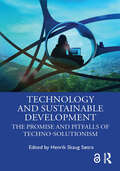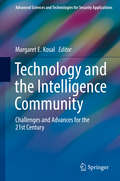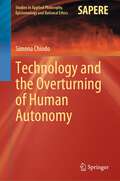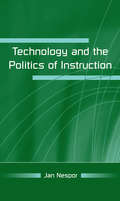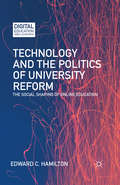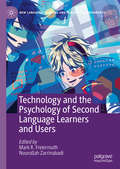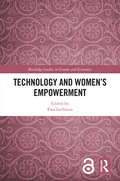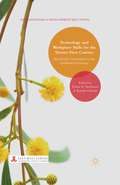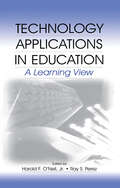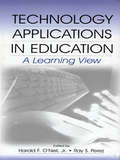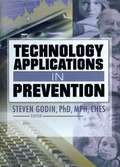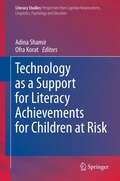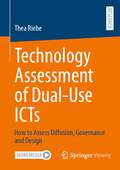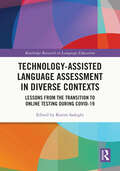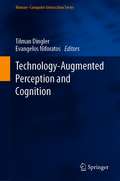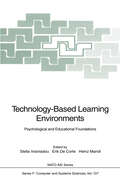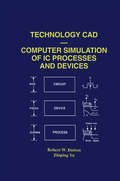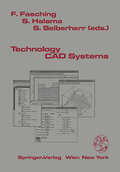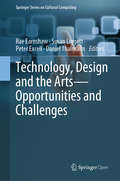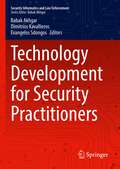- Table View
- List View
Technology and Sustainable Development: The Promise and Pitfalls of Techno-Solutionism
by Henrik Skaug SætraTechnological change is at the core of all major disruptions in human history, and revolutions, wars, and general development are regularly connected to some sort of technological change. However, not all development is beneficial. While technology has fueled great innovations and rapid development, the notion of sustainable development has gained prominence as we now experience serious social, economic, and environmental challenges. This book examines whether technology can be used to fix the very problems caused by technology, as the various chapters examine different aspects related to how technology has brought us where we are today (which some will say is the best place humanity’s been at according to a range of metrics), and whether technology helps or hinders us in our efforts to solve the challenges we currently face. The issues discussed cover the three sustainability dimensions and include topics such as the materiality of AI, technology in education, AI for gender equality, innovation and the digital divide, and how technology relates to power, the political system, and capitalism. The chapters all build on the theoretical backdrop of technological change, sustainable development, and the UN’s Sustainable Development Goals are actively used throughout this book, both to examine how these goals capture or overlook central elements of sustainable development, and also to facilitate and create a common framework of engagement between the chapters. This book provides a novel combination of traditional theories that are explored through different case studies, providing the ground for a better understanding of how and when technology can –and cannot –be the enabler of sustainable development. It is thus an important resource for students of all disciplines, technologists, and those developing and applying new technologies. It is also a valuable resource for politicians and regulators attempting to harness the power of technology for good, while limiting its negative potential. The Open Access version of this book, available at www.taylorfrancis.com, has been made available under a Creative Commons [Attribution-Non Commercial-No Derivatives (CC-BY-NC-ND)] 4.0 license. Funded by Ostfold University College.
Technology and Sustainable Development: The Promise and Pitfalls of Techno-Solutionism
Technological change is at the core of all major disruptions in human history, and revolutions, wars, and general development are regularly connected to some sort of technological change. However, not all development is beneficial. While technology has fueled great innovations and rapid development, the notion of sustainable development has gained prominence as we now experience serious social, economic, and environmental challenges. This book examines whether technology can be used to fix the very problems caused by technology, as the various chapters examine different aspects related to how technology has brought us where we are today (which some will say is the best place humanity’s been at according to a range of metrics), and whether technology helps or hinders us in our efforts to solve the challenges we currently face. The issues discussed cover the three sustainability dimensions and include topics such as the materiality of AI, technology in education, AI for gender equality, innovation and the digital divide, and how technology relates to power, the political system, and capitalism. The chapters all build on the theoretical backdrop of technological change, sustainable development, and the UN’s Sustainable Development Goals are actively used throughout this book, both to examine how these goals capture or overlook central elements of sustainable development, and also to facilitate and create a common framework of engagement between the chapters. This book provides a novel combination of traditional theories that are explored through different case studies, providing the ground for a better understanding of how and when technology can –and cannot –be the enabler of sustainable development. It is thus an important resource for students of all disciplines, technologists, and those developing and applying new technologies. It is also a valuable resource for politicians and regulators attempting to harness the power of technology for good, while limiting its negative potential. The Open Access version of this book, available at www.taylorfrancis.com, has been made available under a Creative Commons [Attribution-Non Commercial-No Derivatives (CC-BY-NC-ND)] 4.0 license. Funded by Ostfold University College.
Technology and the Intelligence Community: Challenges and Advances for the 21st Century (Advanced Sciences and Technologies for Security Applications)
by Margaret E. KosalThis volume examines the role of technology in gathering, assimilating and utilizing intelligence information through the ages. Pushing the boundaries of existing works, the articles contained here take a broad view of the use and implementation of technology and intelligence procedures during the cold war era and the space race, the September 2011 attacks, and more recent cyber operations. It looks at the development of different technologies, procedural implications thereof, and the underlying legal and ethical implications. The findings are then used to explore the future trends in technology including cyber operations, big data, open source intelligence, smart cities, and augmented reality. Starting from the core aspects of technical capabilities the articles dig deeper, exploring the hard and soft infrastructure of intelligence gathering procedures and focusing on the human and bureaucratic procedures involved therein.Technology and innovation have played an important role in determining the course of development of the intelligence community. Intelligence gathering for national security, however, is not limited only to the thread of technical capabilities but is a complex fabric of organizational structures, systemic undercurrents, and the role of personnel in key positions of decision making. The book’s findings and conclusions encompass not just temporal variation but also cut across a diverse set of issue areas. This compilation is uniquely placed in the interdisciplinary space combining the lessons from key cases in the past to current developments and implementation of technology options.
Technology and the Overturning of Human Autonomy (Studies in Applied Philosophy, Epistemology and Rational Ethics #66)
by Simona ChiodoThis book offers an extensive historical, philosophical and ethical discussion on the role of autonomous technologies, and their influence on human identity. By connecting those different perspectives, and analysing some practical case studies, it guides readers to dissect the relationship between machine and human autonomy, and machine and human identity. It analyses how the relationship between human and technology has been evolving in the last few centuries. Last, it aims at proposing an explanation on the reason/s why humans have been keen on developing their own autonomy’s perfect avatar.
Technology and the Politics of Instruction
by Jan NesporIn this study of computer-mediated instruction (CMI) in a U.S. research university that is the site of nationally known innovations in this area, Jan Nespor traces the varying material and organizational entanglements of a constantly reconfiguring network of people, things, categories, and ideas that are sometimes loosely, sometimes tightly entangled in forms of CMI. He unfolds how the different forms and meanings of CMI policy and practice were constructed over time, across departments, and in relation to students’ academic trajectories. Tying together a range of issues usually separated in discussions of instructional technology and examining often slighted topics, such as the articulations of local and national practices, this book questions the common vocabulary for making sense of CMI and contributes to educational change theory by showing how CMI has evolved both from the top-down and the bottom-up. Technology and the Politics of Instruction is distinctive in its multi-level approach and in the breadth of its conceptual frame. Departing from the mainstream research on instructional technology to focus on mundane and widespread forms of CMI—PowerPoint slides, CD-ROMs, self-paced labs, and the like—Nespor views these from multiple standpoints, not just what they mean for professors, but also for administrators and students. The effect is to displace the typical emphasis in CMI research from cutting-edge, high resource artifacts and systems (the importance of which is not questioned) to the politics and organizational processes that shape the uses of such things. This book is intended primarily for scholars and students in the fields of educational and more broadly organizational change, the politics and sociology of education, curriculum theory, higher education, and educational administration, and will also interest instructional technologists and technology developers.
Technology and the Politics of Instruction
by Jan NesporIn this study of computer-mediated instruction (CMI) in a U.S. research university that is the site of nationally known innovations in this area, Jan Nespor traces the varying material and organizational entanglements of a constantly reconfiguring network of people, things, categories, and ideas that are sometimes loosely, sometimes tightly entangled in forms of CMI. He unfolds how the different forms and meanings of CMI policy and practice were constructed over time, across departments, and in relation to students’ academic trajectories. Tying together a range of issues usually separated in discussions of instructional technology and examining often slighted topics, such as the articulations of local and national practices, this book questions the common vocabulary for making sense of CMI and contributes to educational change theory by showing how CMI has evolved both from the top-down and the bottom-up. Technology and the Politics of Instruction is distinctive in its multi-level approach and in the breadth of its conceptual frame. Departing from the mainstream research on instructional technology to focus on mundane and widespread forms of CMI—PowerPoint slides, CD-ROMs, self-paced labs, and the like—Nespor views these from multiple standpoints, not just what they mean for professors, but also for administrators and students. The effect is to displace the typical emphasis in CMI research from cutting-edge, high resource artifacts and systems (the importance of which is not questioned) to the politics and organizational processes that shape the uses of such things. This book is intended primarily for scholars and students in the fields of educational and more broadly organizational change, the politics and sociology of education, curriculum theory, higher education, and educational administration, and will also interest instructional technologists and technology developers.
Technology and the Politics of University Reform: The Social Shaping of Online Education (Digital Education and Learning)
by E. HamiltonDo new technologies mean the end of the university as we know it? Or can they be shaped in a way that balances innovation and tradition? This volume explores these questions through a critical history of online education.
Technology and the Psychology of Second Language Learners and Users (New Language Learning and Teaching Environments)
by Nourollah Zarrinabadi Mark R. FreiermuthThis edited volume brings together large-scale research as well as case studies from a range of geographical contexts and represents a variety of educational settings involving second language learners and users. Its aim is to explore the interrelated issues of psychology and technology use in second language learning settings as well as in more autonomous environments. As language learning professionals continue to devote more time and attention to making various technological tools an integral part of the classroom, it is just as important to understand the influences that these tools have on the psychological state of the learners who use them. In consideration of this objective, the volume examines factors such as learner attitudes and motivation, emotion and behaviour, and the cognitive processes that are at play in the minds of the language users. This volume will be of interest not only to language teachers but also to researchers working in second language acquisition (SLA), applied linguistics, and educational psychology.
Technology and Women's Empowerment (Routledge Studies in Gender and Economics)
by Ewa LechmanThe near-ubiquitous spread of ICT offers unprecedented opportunities for social and economic agents, reshapes social and economic structures and drives the emergence of socioeconomic networks. This book contributes to the growing body of literature and present state of knowledge, offering the reader broad evidence on how new information and communication technologies impact women’s economic and social empowerment and hence have an impact on overall welfare creation. More specifically, it concentrates on demonstrating how ICT may become "empowering technologies" through their implementation. The book is designed to provide deep insight into the theoretical and empirical evidence on ICT as a significant driver of women`s social and economic development. Special focus is given to examining the following broad topics: channels of ICT impact on women's development; the role of ICT in enhancing women's active participation in formal labor markets; examples of how ICT encourages education, skills development, institutions development et alia, and thus contributes to women’s social and economic empowerment, as well as case-based evidence on ICT's role in fostering women’s equality. The primary audience for the book will be scholars and academic professionals from a wide variety of disciplines but mainly those who are concerned with addressing the issues of economic development and growth, social development, the role of technology progress in the context of broadly defined socioeconomic progress.
Technology and Women's Empowerment (Routledge Studies in Gender and Economics)
by Ewa LechmanThe near-ubiquitous spread of ICT offers unprecedented opportunities for social and economic agents, reshapes social and economic structures and drives the emergence of socioeconomic networks. This book contributes to the growing body of literature and present state of knowledge, offering the reader broad evidence on how new information and communication technologies impact women’s economic and social empowerment and hence have an impact on overall welfare creation. More specifically, it concentrates on demonstrating how ICT may become "empowering technologies" through their implementation. The book is designed to provide deep insight into the theoretical and empirical evidence on ICT as a significant driver of women`s social and economic development. Special focus is given to examining the following broad topics: channels of ICT impact on women's development; the role of ICT in enhancing women's active participation in formal labor markets; examples of how ICT encourages education, skills development, institutions development et alia, and thus contributes to women’s social and economic empowerment, as well as case-based evidence on ICT's role in fostering women’s equality. The primary audience for the book will be scholars and academic professionals from a wide variety of disciplines but mainly those who are concerned with addressing the issues of economic development and growth, social development, the role of technology progress in the context of broadly defined socioeconomic progress.
Technology and Workplace Skills for the Twenty-First Century: Asia Pacific Universities in the Globalized Economy (International and Development Education)
by Deane E. Neubauer Kamila GhazaliTechnology and Workplace Skills for the Twenty-First Century examines many of the rapid changes taking place at the intersection of workplace demands and higher education throughout the Asia Pacific region. The globalized, interdependent twenty-first century workforce is built around computing, communication, and automation. These characteristics have changed the ways in which higher education is connected to the workforce and raised the stakes for educating students for the changing workforce. In this book, scholars and education leaders throughout Asia Pacific and the US investigate how the changing needs of the workforce have shaped higher education's curriculum, methods, and orientation, and show how different Asia Pacific countries have responded differently to these challenges.
Technology Applications in Education: A Learning View
by Ray S. Perez Harold F. O'NeilThis volume identifies promising learning, teaching, and assessment strategies for the use and assessment of technology in educational settings, specifically: *educational context (e.g., organizational and structural factors that contribute to the effective use of technology in school settings); *promising learning and teaching strategies; *promising technology-based assessment procedures and methods; *policy implementation issues; and *a summary of current research on the effective use of technology in education. Chapter authors represent a variety of perspectives and disciplines, from computer science, cognitive and educational psychology, and educational administration. Authors represent government, business, and university communities from within and outside the U.S. These multiple perspectives contribute to the overall understanding of current technology use in education and help in identifying future research needs. Technology Applications in Education: A Learning View explores the state of the art of technology in K-16 education from a learning perspective rather than a hardware/software view. It is designed for professionals and graduate students in the educational technology, training, assessment/evaluation, school administration, military psychology, and educational psychology communities. This book is characterized in the following montage of factors: *the primacy of learning as a focus for technology implementation; *a focus on technology uses in K-16 education; *a focus on the assessment of both individuals and teams; *a broad variety of methodological approaches from qualitative to instructional design to quantitative (e.g., structural equation modeling); *a need to support the development of technology-based curriculum and tools; and *a need for theory-driven and evaluation studies to increase our knowledge.
Technology Applications in Education: A Learning View
by Ray S. Perez Harold F. O'NeilThis volume identifies promising learning, teaching, and assessment strategies for the use and assessment of technology in educational settings, specifically: *educational context (e.g., organizational and structural factors that contribute to the effective use of technology in school settings); *promising learning and teaching strategies; *promising technology-based assessment procedures and methods; *policy implementation issues; and *a summary of current research on the effective use of technology in education. Chapter authors represent a variety of perspectives and disciplines, from computer science, cognitive and educational psychology, and educational administration. Authors represent government, business, and university communities from within and outside the U.S. These multiple perspectives contribute to the overall understanding of current technology use in education and help in identifying future research needs. Technology Applications in Education: A Learning View explores the state of the art of technology in K-16 education from a learning perspective rather than a hardware/software view. It is designed for professionals and graduate students in the educational technology, training, assessment/evaluation, school administration, military psychology, and educational psychology communities. This book is characterized in the following montage of factors: *the primacy of learning as a focus for technology implementation; *a focus on technology uses in K-16 education; *a focus on the assessment of both individuals and teams; *a broad variety of methodological approaches from qualitative to instructional design to quantitative (e.g., structural equation modeling); *a need to support the development of technology-based curriculum and tools; and *a need for theory-driven and evaluation studies to increase our knowledge.
Technology Applications in Prevention
by Steven GodinControl health care costs with these cost-effective, technology-based prevention/intervention techniques!In 2001, Americans spent $1.4 trillion on health care services. By 2010, health care costs are forecasted to approach 20% of the United States&’ Gross National Product. Technology Applications in Prevention highlights much-needed technology-based prevention/intervention methods that can help contain health costs. "Efficient and Effective Uses of Technology in Community Research" provides the information that future prevention researchers and program evaluators will need to be effective in electronic data collection, management, and cost analysis. "Community Building with Technology: The Development of Collaborative Community Technology Initiatives" presents a case example showing how Web sites can function as regional clearinghouses of useful information and provide convenient forums where agency staff can update their prevention skills. "Applying Web-Based Survey Design Standards" addresses a question critical to professionals in e-data collection: How reliable is Web-based needs assessment and/or outcome data? This chapter suggests standards that should be adhered to in Internet-based data collection. "Assessing Quality Assurance of Self-Help Sites on the Internet" and "The Quality of Spanish Health Information Web Sites: An Emerging Disparity" address the current lack of quality in the health and mental health information available on the World Wide Web. "A Participatory Internet Initiative in an African-American Neighborhood" explores health disparity concerns regarding the use of the Internet. This chapter discusses several ways to empower those who are on the dark side of the "digital divide"-and shows how to ensure that Web-based material is culturally relevant and appropriate for those it is intended to help. "Alcohol Abuse Prevention Among High-Risk Youth" presents a case example of a life-skills based CD-ROM intervention designed to discourage kids from abusing alcohol. "Constructing Better Futures Via Video" looks at video-based futures planning, which combines self-modeling and "feedforward" to forecast a student&’s future capabilities. This technique helps teenagers find meaning in their current educational setting and prepare for adulthood. This chapter also explains how to train school-based personnel to encourage positive attitudes and support the life skills of their students via carefully planned and edited-yet inexpensive-video productions.Why is the information in this book so essential? In 2000, approximately 20% of U.S. employers changed their health insurance plans as a cost savings strategy. American companies and their employees must new deal with new insurance plans that have reduced the breadth of their coverage and/or increased employee deductibles. The need for cost-effective preventive strategies is becoming increasingly more urgent as employers and insurance companies scramble to provide affordable health care coverage. New technologies have opened the door to better, more economical modes of preventive care. This book presents a vital cross-section of the current state of the art in the application of technology to prevention and intervention. Make it a part of your professional/teaching collection today!
Technology Applications in Prevention
by Steven GodinControl health care costs with these cost-effective, technology-based prevention/intervention techniques!In 2001, Americans spent $1.4 trillion on health care services. By 2010, health care costs are forecasted to approach 20% of the United States&’ Gross National Product. Technology Applications in Prevention highlights much-needed technology-based prevention/intervention methods that can help contain health costs. "Efficient and Effective Uses of Technology in Community Research" provides the information that future prevention researchers and program evaluators will need to be effective in electronic data collection, management, and cost analysis. "Community Building with Technology: The Development of Collaborative Community Technology Initiatives" presents a case example showing how Web sites can function as regional clearinghouses of useful information and provide convenient forums where agency staff can update their prevention skills. "Applying Web-Based Survey Design Standards" addresses a question critical to professionals in e-data collection: How reliable is Web-based needs assessment and/or outcome data? This chapter suggests standards that should be adhered to in Internet-based data collection. "Assessing Quality Assurance of Self-Help Sites on the Internet" and "The Quality of Spanish Health Information Web Sites: An Emerging Disparity" address the current lack of quality in the health and mental health information available on the World Wide Web. "A Participatory Internet Initiative in an African-American Neighborhood" explores health disparity concerns regarding the use of the Internet. This chapter discusses several ways to empower those who are on the dark side of the "digital divide"-and shows how to ensure that Web-based material is culturally relevant and appropriate for those it is intended to help. "Alcohol Abuse Prevention Among High-Risk Youth" presents a case example of a life-skills based CD-ROM intervention designed to discourage kids from abusing alcohol. "Constructing Better Futures Via Video" looks at video-based futures planning, which combines self-modeling and "feedforward" to forecast a student&’s future capabilities. This technique helps teenagers find meaning in their current educational setting and prepare for adulthood. This chapter also explains how to train school-based personnel to encourage positive attitudes and support the life skills of their students via carefully planned and edited-yet inexpensive-video productions.Why is the information in this book so essential? In 2000, approximately 20% of U.S. employers changed their health insurance plans as a cost savings strategy. American companies and their employees must new deal with new insurance plans that have reduced the breadth of their coverage and/or increased employee deductibles. The need for cost-effective preventive strategies is becoming increasingly more urgent as employers and insurance companies scramble to provide affordable health care coverage. New technologies have opened the door to better, more economical modes of preventive care. This book presents a vital cross-section of the current state of the art in the application of technology to prevention and intervention. Make it a part of your professional/teaching collection today!
Technology as a Support for Literacy Achievements for Children at Risk (Literacy Studies #7)
by Adina Shamir and Ofra KoratPresenting cutting-edge studies from various countries into the theoretical and practical issues surrounding the literacy acquisition of at-risk children, this volume focuses specifically on the utility of technology in supporting and advancing literacy among the relevant populations. These include a range of at-risk groups such as those with learning disabilities, low socioeconomic status, and minority ethnicity. Arguing that literacy is a key requirement for integration into any modern society, the book outlines new ways in which educators and researchers can overcome the difficulties faced by children in these at-risk groups. It also reflects the rapid development of technology in this field, which in turn necessitates the accumulation of fresh research evidence.
Technology Assessment of Dual-Use ICTs: How to Assess Diffusion, Governance and Design
by Thea RiebeInformation and Communication Technologies (ICTs) are important to human, national, and even international security. IT research, artifacts, and knowledge that can be applied in military and civilian contexts, used as part of weapon systems, or cause significant harm are referred to as dual-use. Advances in artificial intelligence (AI), robotics, cybersecurity, and open source intelligence (OSINT) raise questions about their dual-use risks. But how can dual-use of such disparate technologies be assessed? Case studies are still lacking on how to assess dual-use ICT and how to enable sensitive and responsible dual-use design. To address the research gap, this cumulative dissertation uses Technology Assessment (TA) as an epistemological framework to bring together approaches of Critical Security Studies (CSS) as well as Value Sensitive Design (VSD) from the field of Human-Computer Interaction (HCI). As a result, the dissertation systematizes the dual-use risks and scenarios of the selected ICTs and derives organizational and design implications.
Technology-Assisted Language Assessment in Diverse Contexts: Lessons from the Transition to Online Testing during COVID-19 (Routledge Research in Language Education)
by Karim SadeghiThis timely collection explores the role of digital technology in language education and assessment during the COVID-19 pandemic. It recognises the unique pressures which the COVID-19 pandemic placed on assessment in language education, and examines the forced shift in assessment strategies to go online, the existing shortfalls, as well as unique affordances of technology-assisted L2 assessment. By showcasing international examples of successful digital and computer-assisted proficiency and skills testing, the volume addresses theoretical and practical concerns relating to test validity, reliability, ethics, and student experience in a range of testing contexts. Particular attention is given to identifying lessons and implications for future research and practice, and the challenges of implementing unplanned computer-assisted language assessment during a crisis. Insightfully unpacking the ‘lessons learned’ from COVID and its impact on the acceleration of the shift towards online course and assessment delivery, it offers important guidelines for navigating assessment in different instructional settings in times of crisis. It will appeal to scholars, researchers, educators, and faculty with interests in educational measurement, digital education and technology, and language assessment and testing.
Technology-Assisted Language Assessment in Diverse Contexts: Lessons from the Transition to Online Testing during COVID-19 (Routledge Research in Language Education)
by Karim SadeghiThis timely collection explores the role of digital technology in language education and assessment during the COVID-19 pandemic. It recognises the unique pressures which the COVID-19 pandemic placed on assessment in language education, and examines the forced shift in assessment strategies to go online, the existing shortfalls, as well as unique affordances of technology-assisted L2 assessment. By showcasing international examples of successful digital and computer-assisted proficiency and skills testing, the volume addresses theoretical and practical concerns relating to test validity, reliability, ethics, and student experience in a range of testing contexts. Particular attention is given to identifying lessons and implications for future research and practice, and the challenges of implementing unplanned computer-assisted language assessment during a crisis. Insightfully unpacking the ‘lessons learned’ from COVID and its impact on the acceleration of the shift towards online course and assessment delivery, it offers important guidelines for navigating assessment in different instructional settings in times of crisis. It will appeal to scholars, researchers, educators, and faculty with interests in educational measurement, digital education and technology, and language assessment and testing.
Technology-Augmented Perception and Cognition (Human–Computer Interaction Series)
by Tilman Dingler Evangelos NiforatosTools and technologies have long complemented and extended our physical abilities: from pre-historic spearheads to steam-propelled ploughs and high-tech prosthetics. While the development of lenses granted us insights into the micro and macrocosms, new sensors and technologies increasingly augment our cognitive abilities, including memory and perception. This book integrates current research efforts, results, and visions from the fields of computer science, neuroscience, and psychology. It provides a comprehensive overview of the state-of-the-art and future applications of how technologies assist and augment human perception and cognition. Experts in the field share their research and findings on: Working memory enhancementsDigitization of memories through lifelog archivesThe consequences of technology-induced disruptions and forgettingThe creation and utilization of new human senses Ethical and security concerns that arise with augmentation technologies. As technology weaves itself ever deeper into our lives, careful examination of its capabilities, risks and benefits is warranted. While this book focuses on the complementation and augmentation of human capabilities, it serves as a foundation for students, researchers and designers of technologies that push the boundaries of perception and cognition.
Technology-Based Learning Environments: Psychological and Educational Foundations (NATO ASI Subseries F: #137)
by Stella Vosniadou Erik De Corte Heinz MandlThe present volume contains a large number of the papers contributed to the Advanced Study Institute on the Psychological and Educational Foundations of Technology-Based Learning Environments, which took place in Crete in the summer of 1992. The purpose of the Advanced Study Institute was to bring together a small number of senior lecturers and advanced graduate students to investigate and discuss the psychological and educational foundations of technology-based learning environments and to draw the implications of recent research findings in the area of cognitive science for the development of educational technology. As is apparent from the diverse nature of the contributions included in this volume, the participants at the ASI came from different backgrounds and looked at the construction of technology -based learning environments from rather diverse points of view. Despite the diversity, a surprising degree of overlap and agreement was achieved. Most of the contributors agreed that the kinds of technology-supported learning environments we should construct should stimulate students to be active and constructive in their knowledge-building efforts, embed learning in meaningful and authentic activities, encourage collaboration and social interaction, and take into consideration students' prior knowledge and beliefs.
Technology CAD — Computer Simulation of IC Processes and Devices (The Springer International Series in Engineering and Computer Science #243)
by Robert W. Dutton Zhiping Yu129 3.6 Exercises 130 3.7 References. 131 4 PN Junctions 131 4.1 Introduction. 132 4.2 Carrier Densities: Equilibrium Case 4.3 Non-Equilibrium .......... . 139 4.4 Carrier Transport and Conservation 144 4.5 The pn Junction - Equilibrium Conditions. 147 155 4.6 The pn Junction - Non-equilibrium. 4.7 SEDAN Analysis . . . . . . . . . . . . . 166 4.7.1 Heavy Doping Effects ..... . 176 4.7.2 Analysis of High-Level Injection 181 190 4.7.3 Technology-Dependent Device Effects 4.8 Summary 193 4.9 Exercises 193 194 4.10 References. 5 MOS Structures 197 5.1 Introduction ............. . 197 5.2 The MOS Capacitor ........ . 198 5.3 Basic MOSFET I-V Characteristics. 208 5.4 Threshold Voltage in Nonuniform Substrate 217 5.5 MOS Device Design by Simulation . . . . . 224 5.5.1 Body-bias Sensitivity of Threshold Voltage 225 5.5.2 Two-region Model . . . . . . . . 231 5.5.3 MOSFET Design by Simulation. 234 5.6 Summary 240 5.7 Exercises 240 5.8 References. 242 6 Bipolar Transistors 243 6.1 Introduction ... 243 6.2 Lateral pnp Transistor Operation 245 6.3 Transport Current Analysis ... 252 6.4 Generalized Charge Storage Model 260 6.,1) Transistor Equivalent Circuits. 267 6.5.1 Charge Control Model ...
Technology CAD Systems
by Franz Fasching Stefan Halama Siegfried SelberherrAs the cost of developing new semiconductor technology at ever higher bit/gate densities continues to grow, the value of using accurate TCAD simu lation tools for design and development becomes more and more of a necessity to compete in today's business. The ability to tradeoff wafer starts in an advanced piloting facility for simulation analysis and optimization utilizing a "virtual fab" S/W tool set is a clear economical asset for any semiconductor development company. Consequently, development of more sophisticated, accurate, physics-based, and easy-to-use device and process modeling tools will receive continuing attention over the coming years. The cost of maintaining and paying for one's own internal modeling tool development effort, however, has caused many semiconductor development companies to consider replacing some or all of their internal tool development effort with the purchase of vendor modeling tools. While some (noteably larger) companies have insisted on maintaining their own internal modeling tool development organization, others have elected to depend totally on the tools offered by the TCAD vendors and have consequently reduced their mod eling staffs to a bare minimal support function. Others are seeking to combine the best of their internally developed tool suite with "robust", "proven" tools provided by the vendors, hoping to achieve a certain synergy as well as savings through this approach. In the following sections we describe IBM's internally developed suite of TCAD modeling tools and show several applications of the use of these tools.
Technology, Design and the Arts - Opportunities and Challenges (Springer Series on Cultural Computing)
by Rae Earnshaw Susan Liggett Peter Excell Daniel ThalmannThis open access book details the relationship between the artist and their created works, using tools such as information technology, computer environments, and interactive devices, for a range of information sources and application domains. This has produced new kinds of created works which can be viewed, explored, and interacted with, either as an installation or via a virtual environment such as the Internet. These processes generate new dimensions of understanding and experience for both the artist and the public’s relationships with the works that are produced. This has raised a variety of interdisciplinary opportunities and issues, and these are examined. The symbiotic relationship between artistic works and the cultural context in which they are produced is reviewed. Technology can provide continuity by making traditional methods and techniques more efficient and effective. It can also provide discontinuity by opening up new perspectives and paradigms. This can generate new ideas, and produce a greater understanding of artistic processes and how they are implemented in practice. Tools have been used from the earliest times to create and modify artistic works. For example, naturally occurring pigments have been used for cave paintings. What has been created provides insight into the cultural context and social environment at the time of creation. There is an interplay between the goal of the creator, the selection and use of appropriate tools, and the materials and representations chosen. Technology, Design and the Arts - Opportunities and Challenges is relevant for artists and technologists and those engaged in interdisciplinary research and development at the boundaries between these disciplines.
Technology Development for Security Practitioners (Security Informatics and Law Enforcement)
by Babak Akhgar Dimitrios Kavallieros Evangelos SdongosThis volume is authored by a mix of global contributors from across the landscape of academia, research institutions, police organizations, and experts in security policy and private industry to address some of the most contemporary challenges within the global security domain. The latter includes protection of critical infrastructures (CI), counter-terrorism, application of dark web, and analysis of a large volume of artificial intelligence data, cybercrime, serious and organised crime, border surveillance, and management of disasters and crises. This title explores various application scenarios of advanced ICT in the context of cybercrime, border security and crisis management, serious and organised crime, and protection of critical infrastructures. Readers will benefit from lessons learned from more than 30 large R&D projects within a security context. The book addresses not only theoretical narratives pertinent to the subject but also identifies current challenges and emerging security threats, provides analysis of operational capability gaps, and includes real-world applied solutions.Chapter 11 is available open access under a Creative Commons Attribution 3.0 IGO License via link.springer.com.
